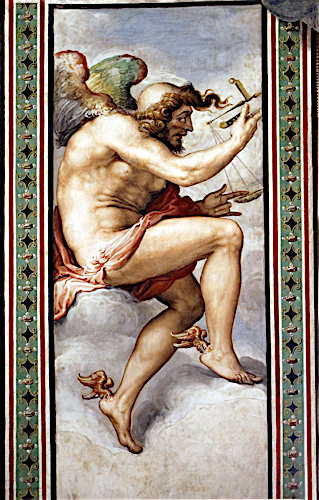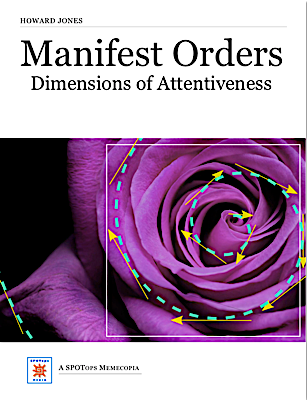Outside time, on a bowline
Every moment, we choose, either through action or inaction, from among available options. Specifics of one's context, as well as past events, constrain the range of available options.

Choices made, or not made, coalesce into the next opportunities. And in that next instant we again elect from among alternatives just delivered from the previous passing moment. Each subsequent instant becomes actual and itself promotes possibilities of the next. And so it goes. Over and over. Again and again. And so we think we live in time.

But actually, we live in change. Each next choice-laden moment matures from a previous. Each is only partially determined by context and past. Now, through our attentiveness, it gains fully concrete realization. One "firms up" discovery of its full implications. Each moment is partially determined by its specific context, yet also it is partially created in one's manner of activity.
But once accomplished, no moment can be undone. We can't go back, so we infer that "relentless time" only has direction "forward". But chronology is merely a sequence among memories that we recall. A person without memory is outside time. A person for whom memory is uncertain escapes its tyranny. There, every moment is a child born as imaginal spawn.
Meditation aspires to timeless contemplation. Ceaseless musing of personal psychic flow leads to a sense of time's illusory pretense. In that realization, one's psyche dwells outside time. It is the emptied fullness of M0. There we gather that time is an accounting trick the mind uses. It simply "keeps everything from having happened all at once". And it makes language possible.
But there is a cross-current among our fortunes. Waves of prospect ripple across contexts of our respective lives. Not so much vengeful karma as echoes of earlier events, shapes of which resonate among later happenstance. Topographies of possibility shape what may yet be. The ancient Greeks dubbed this aspect of change Kairos, their god of opportunity. Seize him by the forelock as he runs by, they advised, otherwise opportunity escapes.

Convergences of opportunities among present prospects ever drive invention, discovery, innovation, and elaboration. Outside domains of reductionist science echo the forms of accomplished events resonating in surprising realizations of aesthetic dynamics.
Computed forms of virtual and augmented reality now open new dimensions of creative opportunity. Alfred Whitehead's and Charles Hartshorne's philosophies of process-relational reality have awakened to a garden of cybernetic possibilities. We enter C5, a cultural prospect of organic wholeness.
Fully beneficent realization of these new opportunities calls for a more discriminating view of the multidimensional processes underlying actualization: conscious attentiveness. Creative prospects are available in each person's attended moments. We need to learn how to recognize and share those unique kairotic glimpses.
Consider something as simple as a knot.

But what kind of knot? If you master only one knot in your entire life, it should be the bowline. Learn to tie it. And learn to tie it quickly.
Should you ever need to secure a lifeline to pull either you or your loved ones from a raging flood or other hazard, you'll be glad to have learned this simple action pattern:
- Hold the long standing part of the rope in your left hand.
- Grasp the rope end in your right between the index and middle finger. Lay the rope end over the standing rope length.
- Rotate your right fingers down and around to form a loop at your left hand.
- Maneuver your right fingers with the rope end to protrude freely above the loop.
- Grasp the rope end with your left and pull it across the loop back under and around the standing rope length.
- Bring the rope end back into the loop and pull it through.
- Bring the rope end well beyond the loop while pulling outward along the standing length with your left hand to begin closing the loop.
- Pull the knot tightly and test it with your weight.

We shall use this set of information to talk about a way of understanding actual prospects and possibilities. Unless one consciously takes charge, in an emergency the unconscious will spur some sort of action, futile or not. If all becomes a blur, one's M0 undifferentiated awareness of occurrence has taken charge.
But in an emergency, if you have practiced and practiced, you reach for the rope and your hands quickly tie a bowline that will securely hold to the very limits of the rope's strength. That is a M1 moment. One reaches automatically for the rope and ties a bowline with practiced hands and fingers nimbly contriving one through muscle patterns stored in memory.
Where practice never happened, one might try to recall the best knot, searching memory trying to recall what kind is the most secure. M2 is where attentiveness deals with kinds of things and relationships. It is useful, convenient and powerful, but in an emergency, every moment thinking about something, even how to save a life, delays any actual rescue.
And once there is recall, "Oh, yes, a bowline," there is that further delay of accessing even more complex stores of information at M3 and M4, "Now, how is that tied?"
If you haven't noted and worked through the intricacies of how the end of the rope goes up through the standing loop and under the standing part and back through the loop to be locked into place, then you'll have to spend time trying to figure it out in M4. An emergency is no place for empirical solution-seeking!
The general rule of attentiveness: learn to do important things so well that they happen automatically as a desired result at M1. This is the rule of warriors, martial artists, hunters, gunslingers, survivalists, surgeons and emergency personnel. At M1 we are attentive to an intent. We act directly, quickly, and surely.
M2 is where we pay attention to "kinds" of things or beings among varied candidates. You know your relatives in terms of the kind of relationship they have to your mutual ancestors. You know your friends by the kinds of feelings and aspirations you have in common. You know your associates by the kinds of actions they can assist. M2 serves as a "ground of action" for M1 events. We act in terms of the "kinds of" outcomes we aim for.
M3 is where we keep track of relative values among the "natures" of various entities. Among rope knots there are those that secure long objects such as poles or pipes. Among that set there are those that work best in specific applications, wet conditions, perhaps. M3 is a more complex dimension of attentiveness than M1 or M2 because it keeps track of more kinds of information. In fact M2 and M1 patterns always are elements of M3, because M3 depends upon knowing "kinds" of things as well as the actions they are capable of.
M4 is more complex and includes the information handled by the earlier orders. M4 is where specific causes and combinations of events lead to specific outcomes. It is the causal world studied by science and exploited by technology. It is where you have to figure out a solution to a problem because you have not previously resolved it into attentive behaviors at M3, M2, and M1.
We'll save M5 for a later post. M5 is where we are attentive to factors of life that animate ourselves, as well as our fellow creatures. It organizes and elaborates sets of information held as patterns among the lesser orders M4, M3, M2, M1, all within the vitally conscious context of M0.
You can find more information about attentive orders in my earlier Steemit posts, as well as at my companion site, Manifest Orders .
